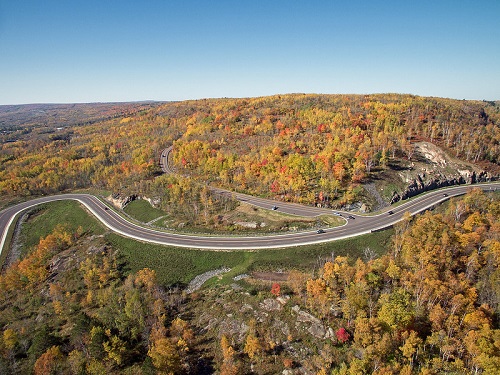A recent study conducted by the University of Minnesota and funded by the Minnesota Local Road Research Board determined that roadside plantings, particularly “turfgrass,” tend to do better when they are both biodiverse and carefully matched to their ideal growing conditions.
[Above photo by the Minnesota DOT]
University researchers noted in a blog post that roadside turfgrass serves the important roles of reducing soil erosion, pollutant runoff, and the spread of invasive weeds, as well as adding visual appeal. However, maintaining it along Minnesota roadsides is difficult because of the harsh climate and roadway maintenance practices, such as road salting and snow plowing in the winter.
“That’s why developing tools for practitioners to make better decisions on revegetating roadsides will save financial resources for Minnesota DOT, practitioners, and local communities,” noted Eric Watkins, a professor with the school’s Department of Horticultural Science and the principal investigator for this study.
The university’s researchers set up 14 test plots along Minnesota roadways and tested 44 treatments mixes. What they found matched up with existing literature compiled from similar reasearch: Biodiversity correlates to better vegetation cover and a decrease in weeds.
“The use of species mixtures, compared to monocultures, has been shown to have multiple benefits,” Watkins noted. “These include more coverage of the seeded species, reduced disease frequency and severity, and extended green color.”
The reason is likely because, within the diverse species mix, the plants have a variety of adaptations and tolerances and thus can survive a wider array of conditions than a single species could, he said.
Yet one “immediate downside” of biodiversity is complications arising from every plant species and subspecies having “wildly different germination rates, rooting depths, and moisture and temperature tolerances,” with interaction among species changing those things even further.
To make it easier for practitioners to implement biodiverse seed mixes, University of Minnesota researchers categorized state roads into three “seeding clusters” – regions based on growing conditions such as temperature, moisture, and soil quality. Two of the seeding clusters are geographic (north Minnesota and central/south Minnesota), with the third is categorized as “poor soil quality” or soil that is sandy, low in organic matter, etc.
“Establishing these test plots with seed mixes that vary by region was an important step in finding the most effective and climate-resistant roadside turfgrass,” explained Dwayne Stenlund, erosion control specialist with Minnesota DOT’s Erosion Control and Stormwater Management unit and the study’s technical liaison.
Moving forward, Watkins said his research team plans to make a web-based version of this seeding “budgeting tool” so it’s easier for local government agencies and the Minnesota DOT to use. They also plan to do more long-term studies at the test plots – their current research only lasted two year – as future seed testing will need to take climate change into account.
“Implementing these mixtures will reduce soil erosion, improve aesthetics, save local communities’ financial resources, and improve the overall environment we occupy,” Watkins added.
Many states are involved in an array of roadside vegetation research to make a variety of environmental improvements.
For example, the Illinois Department of Transportation recounted in a November 2022 blog post how it changed its mowing practices over the years to better protect roadside landscapes that are vital to pollinators and native planet life.
The agency said it adopted mowing policies to protect the habitat and migratory patterns of the monarch butterfly and other pollinators that use it as a food source. That policy allows for mowing of the state’s roads in a four-year rotation during the summer.
Meanwhile, ecologists at Idaho State University are working with the Idaho Transportation Department to turn state roadsides into veritable “Swiss army knives” of vegetation so they are both more fire-resistant and more welcoming to pollinating insects.
Those ecologists are working with three different types of ecosystems at those sites, figuring out how to make the land more hospitable to native plants and less so for invasive weeds. That research also includes increasing the habitat’s fire resistance, while becoming a more attractive habitat for pollinators like bees and butterflies.
